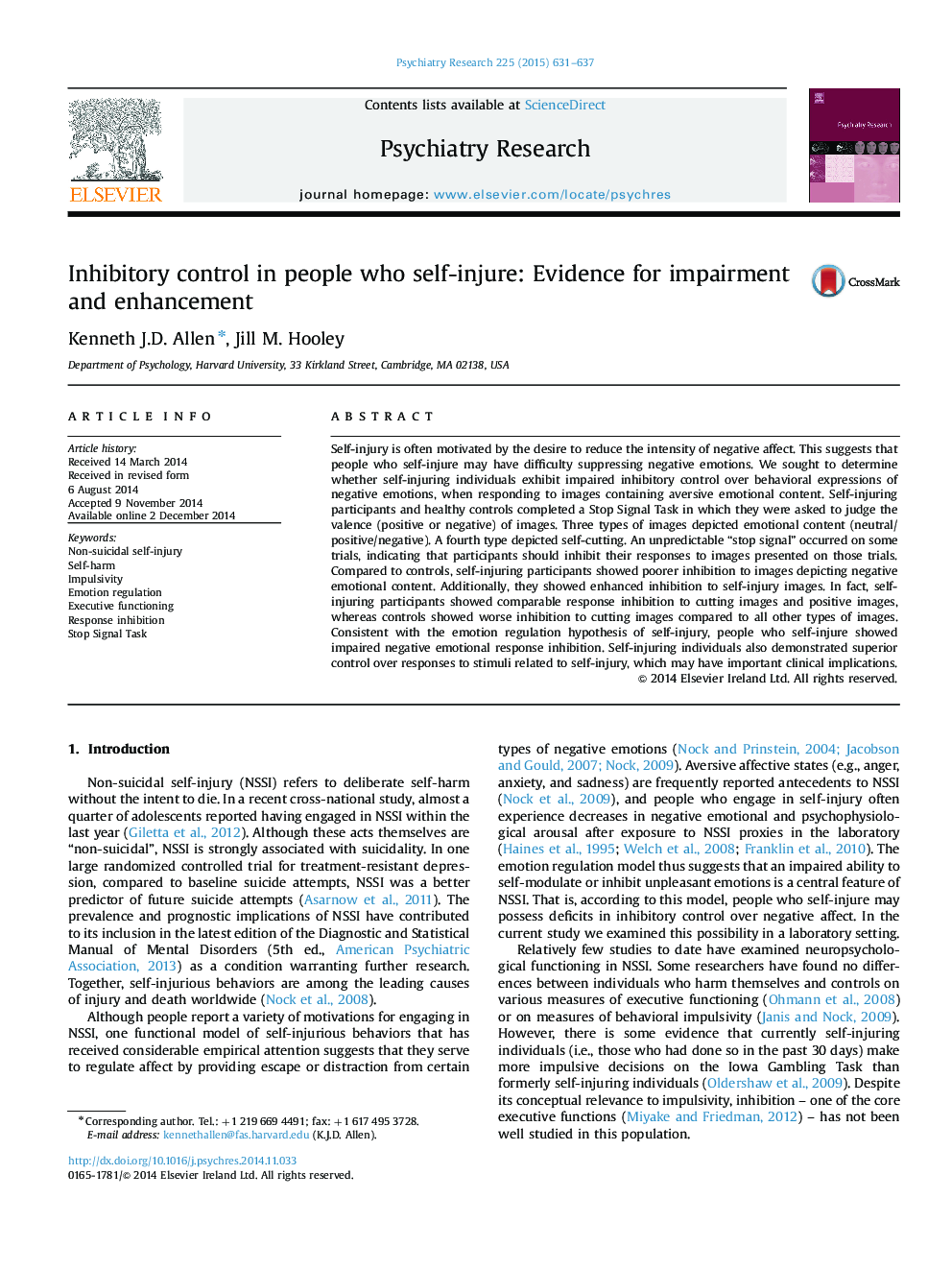| کد مقاله | کد نشریه | سال انتشار | مقاله انگلیسی | نسخه تمام متن |
|---|---|---|---|---|
| 10304185 | 545664 | 2015 | 7 صفحه PDF | دانلود رایگان |
عنوان انگلیسی مقاله ISI
Inhibitory control in people who self-injure: Evidence for impairment and enhancement
ترجمه فارسی عنوان
کنترل مهار کننده در افرادی که صدمات خود را دارند: شواهدی برای اختلال و بهبودی
دانلود مقاله + سفارش ترجمه
دانلود مقاله ISI انگلیسی
رایگان برای ایرانیان
کلمات کلیدی
صدمات غیر خودکشی، صدمه زدن به خود، تکانشی، مقررات احساسی، عملکرد اجرایی، مهار پاسخ توقف کار سیگنال،
ترجمه چکیده
خود آسیب دیده اغلب توسط تمایل به کاهش شدت اثر منفی انگیزه. این نشان می دهد که افرادی که خود صدمه می بینند ممکن است سرکوب احساسات منفی مشکل داشته باشند. ما به دنبال تعیین این موضوع بودیم که آیا افراد مبتلا به خود آسیب دیده، مانع از کنترل عاطفی عاطفی منفی در پاسخگویی به تصاویر حاوی محتوای هیجانی ناگوار می شوند. شرکت کنندگان صدمه زدن و کنترل های سالم تکمیل یک وظیفه سیگنال متوقف کردند که از آنها خواسته شد قضاوت کنندۀ ولنتاین (مثبت یا منفی) تصاویر. سه نوع از تصاویر محتوای احساسی را نشان می دهد (خنثی / مثبت / منفی). نوع چهارم خود برش را نشان می دهد. یک نشانه غیر قابل پیش بینی در برخی از آزمایشات رخ داده است، نشان می دهد که شرکت کنندگان باید پاسخ های خود را به تصاویر ارائه شده در این آزمایش ها مهار کنند. در مقایسه با گروه کنترل، شرکت کنندگان خود آسیب دیده، مهار کننده های ضعیف تر از تصاویری هستند که محتوای احساسی منفی را نشان می دهند. علاوه بر این، آنها بازدارندگی بیشتری را به تصاویر خود آسیب رسانده اند. در واقع، شرکت کنندگان خود آسیب دیده نشان داد که پاسخ منفی نسبت به برش تصاویر و تصاویر مثبت منفی است، در حالیکه کنترل ها مهار نامطلوبتری برای برش تصاویر در مقایسه با سایر انواع تصاویر داشتند. مطابق با فرضیه تنظیم احساسات خود آسیب دیده، افرادی که خود صدمه دیده اند نشان داد که مهار منفی عاطفی منفی منفی. افراد صدمه دیده نیز کنترل بیشتری بر پاسخ به محرک های مربوط به خود آسیب دیده دارند که ممکن است پیامدهای مهم بالینی داشته باشد.
موضوعات مرتبط
علوم زیستی و بیوفناوری
علم عصب شناسی
روانپزشکی بیولوژیکی
چکیده انگلیسی
Self-injury is often motivated by the desire to reduce the intensity of negative affect. This suggests that people who self-injure may have difficulty suppressing negative emotions. We sought to determine whether self-injuring individuals exhibit impaired inhibitory control over behavioral expressions of negative emotions, when responding to images containing aversive emotional content. Self-injuring participants and healthy controls completed a Stop Signal Task in which they were asked to judge the valence (positive or negative) of images. Three types of images depicted emotional content (neutral/positive/negative). A fourth type depicted self-cutting. An unpredictable “stop signal” occurred on some trials, indicating that participants should inhibit their responses to images presented on those trials. Compared to controls, self-injuring participants showed poorer inhibition to images depicting negative emotional content. Additionally, they showed enhanced inhibition to self-injury images. In fact, self-injuring participants showed comparable response inhibition to cutting images and positive images, whereas controls showed worse inhibition to cutting images compared to all other types of images. Consistent with the emotion regulation hypothesis of self-injury, people who self-injure showed impaired negative emotional response inhibition. Self-injuring individuals also demonstrated superior control over responses to stimuli related to self-injury, which may have important clinical implications.
ناشر
Database: Elsevier - ScienceDirect (ساینس دایرکت)
Journal: Psychiatry Research - Volume 225, Issue 3, 28 February 2015, Pages 631-637
Journal: Psychiatry Research - Volume 225, Issue 3, 28 February 2015, Pages 631-637
نویسندگان
Kenneth J.D. Allen, Jill M. Hooley,
